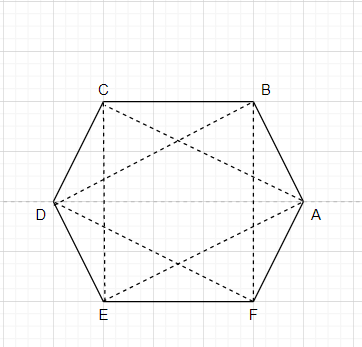Question
Question: Three of six vertices of a regular hexagon are chosen at random. The probability that the triangle w...
Three of six vertices of a regular hexagon are chosen at random. The probability that the triangle with three vertices is equilateral, is equal to
Solution
Hint:First of all, find the total number of triangles that is possible by taking 3 points of a regular hexagon which has 6 vertices. Total number of triangles is 6C3 . ΔDFB and ΔAECare those triangles which have all of three sides equal to each other. So, there are two equilateral triangles possible in a regular hexagon. Probability can be calculated using the formula , Probability=total number of triangles possibletotal number of equilateral triangles.
Complete step-by-step answer:

We have connected the vertex A,E and C and can see that we got an equilateral triangle.
Similarly, We have connected the vertex D,F and B and can see that we got an equilateral triangle.
Suppose if we connect the vertex A,D and E, we don’t get an equilateral triangle. Because, according to the diagram we can see that all three sides are not equal to each other.
We have only two equilateral triangles to be formed using a regular hexagon. Out of six points in a hexagon, we have to select only three points at a time.
The total number of triangles to be formed using a regular hexagon=
6C3 ways
